Abstract
In Africa, camel herding is often viewed as a subsistence or ancient activity restricted to marginal drylands and arid or desert zones. However, camel products are increasingly sold in many cities, and camels are more and more used for tourist purposes. We can also see various public or private interventions in the arid zones aiming to develop processing units for milk or meat based on a business model. This present research aimed to evaluate the multiple economic and non-economic contributions of camel activities in North African drylands through analysis at the household and territorial levels using a multifunctional approach. Based on a study in five provinces of East and South Morocco, this article proposes a framework based on rural livelihoods and ecosystemic services for assessing the contribution of camel rearing to the rural economy and territorial development. It highlighted the multiple economic and non-economic functions of this activity, including domestic, trade, and services, as well as cultural attachment and local knowledge. We conclude by discussing current changes in camel herding, between supporting specialization for value chain participation and maintaining the overall sustainability of the camel systems in dryland areas.
Introduction
Over the last two decades, camel herding has been considered with renewed interest. This trend is observed at the global scale, as the camel population has increased of around 46% between 2001 and 2018, compared to 6% in the previous two-decades (1981–2000) (FAO, 2020). Even if this significant jump in the camel population is due to statistical readjustments, following recent censuses in related countries, it reveals a new trend in camel livestock herding (Faye, 2019, 52). In Africa, camel population counted about 34 million heads in 2021, which is around ten times less than cattle, sheep or goats population (FAO, 2023), but with higher importance in arid environments: the share of camel population in the domestic herbivore biomass can reach 12% in the Horn of Africa, and even exceed 30% in other arid regions, “for example in Mauritania (37%), Emirates and Qatar (47%), Chad (50%), Somalia (52%), or Western Sahara/Saharan provinces of Morocco (84%)” (Faye, 2019, 53). This geographical distribution of camel population is mainly due to its capacity of resistance to heat, dehydration and protein and mineral undernutrition, which makes it one of the most adapted species to extreme conditions in the desert and arid to semi-arid belt of the African continent (Senoussi, 2011). The camel adaptation to harsh environment has been well documented through a biological and zootechnical perspective (Faye et al., 2004; Kaufmann, 2005). More recently, with the climate warming and the socioeconomic challenges to maintain activities in these dry areas, researchers focused more and more on the demographic parameters and productivity of the animal in relation to the breeding systems (Faye, 2018; Julien et al., 2021). Other recent research programs addressed more specifically the potential development of camel milk and meat value chains (Farah, 1993; Konuspayeva et al., 2009).
However, the literature has not properly addressed the monetary and non-monetary contributions of camel herding to household and territorial economies. Camel activity based on mobility is often viewed as a living pattern more than a profitable activity. Moreover, there is a lack of data about the economic value of this activity, which generally develops in very harsh and remote areas. Collecting data is therefore essential to identify development strategies of camel breeding that can strengthen the economies of arid and semi-arid areas. Only data-based evidence can help in discussion with policymakers and development agencies. The purpose of this article, based on a case study conducted in Morocco, is to contribute information and understand how this activity could contribute to rural economy and territorial development of the arid and desert areas.
Material and methods
Study area from east to West of the South Morocco
To analyze the diversity of camel-based systems and their functions, field work had been organized in Moroccan Saharan and pre-Saharan areas, where camel herding is particularly important. In the south east zone, dominated by oasis and mountainous lands, three provinces were selected: Zagora and Errachidia (located in the Draa-Tafilalet region) and Figuig (located in the south of the Oriental and Rif region). In the south west desertic areas, three provinces were chosen: Guelmim, Tan-Tan and Assa-Zag (all located in the region of Guelmim-Oued Noun) (Figure 1). These 2 areas are characterized by extreme temperatures as well as rare and irregular rainfall. In the Guelmim region, the annual average rainfall is between 47 et 117 milimeters (HCP, 2019). In the south east regions, rainfall rarely exceed 150 mm (HCP, 2021). Rangeland vegetation is essentially composed of “steppe with some thorny trees and shrubs such as acacias and ziziphus as well as many perennial and annual grasses and other ephemeral herbaceous vegetation” (Davis, 2005, 514), which are scattered among the stony surfaces of the plateau (hamada) and the sandy plains of the desert (erg) (Amsidder et al., 2021).
FIGURE 1
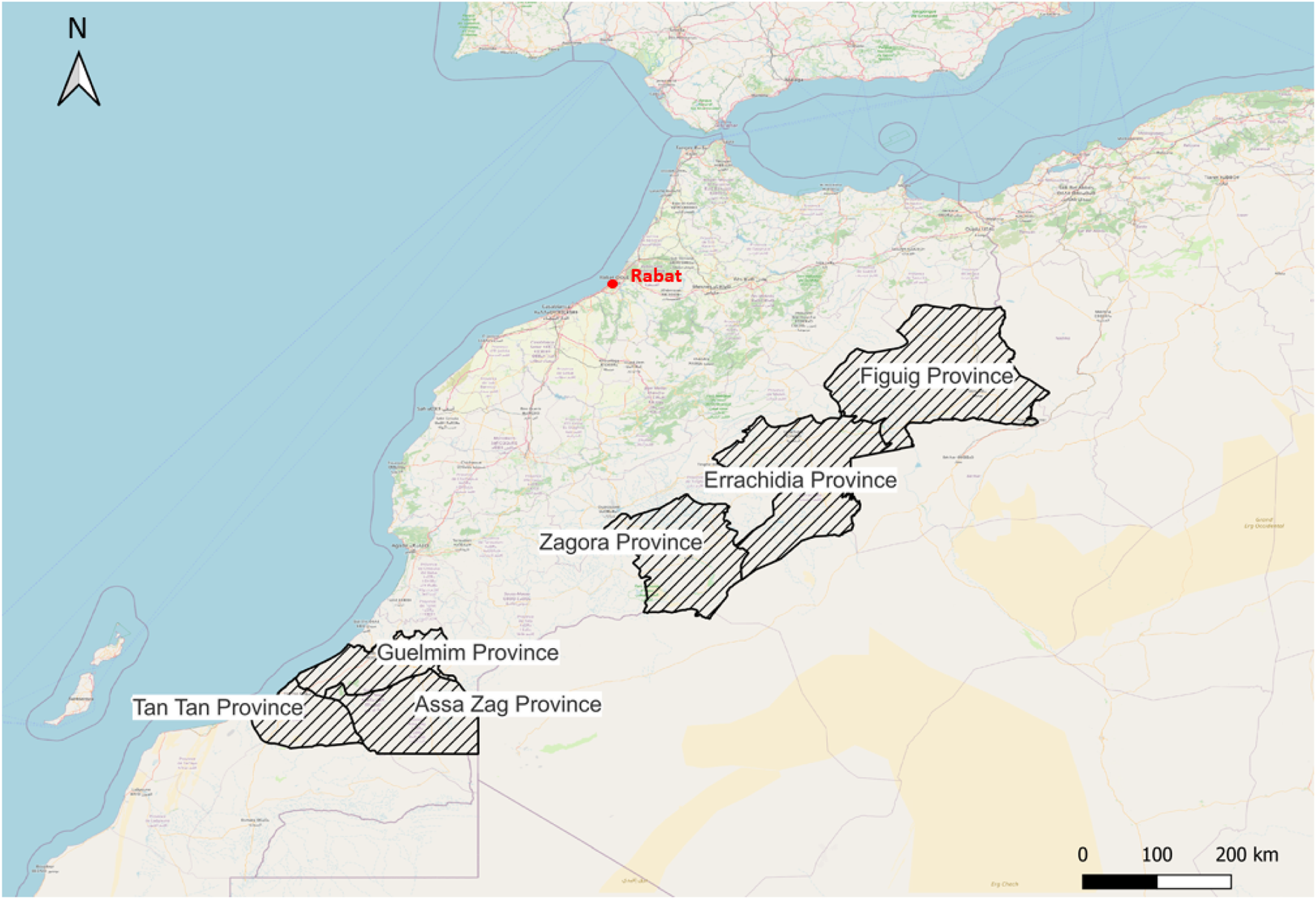
Delimitation of the 6 Moroccan Saharan and pre-Saharan studied provinces.
The study areas were historically crossed by caravan roads leading to the Sahel regions of West Africa (Lazarev, 2015). This situation made them attractive to populations from both north and south of the Sahara, resulting in significant social diversity. This diversity persists still today despite the decline of caravan trade at the turn of the 20th century. This includes Arabic tribes like Arib, Aït Oussa, Yaggout, Aït Lahcen, and Azouafit as the most important and Berber tribes such as Aït Bâamrane and Ait Atta. Descendants of sub-Saharan African slaves, as the Draoua, were also met downstream the Drâa Valley (Amsidder et al., 2021; Amsidder, 2022).
Conceptual framework
Assessing the economic contribution of pastoral systems in developing countries represents a conceptual and methodological challenge, due to the importance of the monetary and non-monetary values generated from the pastoral system and also the complexity to obtain representative and updated data. Hesse and Macgregor (2009) proposed that the values of “direct” and “indirect” economics be differentiated. Direct economic values refer to (i) subsistence and livelihood values, (ii) economic values related to marketed and non-marketed products, and (iii) Human capital values such as employment and other skills and capacities. Indirect economic values refer to input values produced by pastoralism, such as those used in agricultural production (like manure or urine) and tourism activities. Those economic values do not include environmental values such as nutrient recycling, biodiversity, etc.
In complement to the approach proposed by these authors, we proposed to refer to the operational frame of indicators proposed in Alary et al. (2022) that proposed to assess the role of livestock as a saving for investment or net safety. By crossing these two frames, a conceptual framework was developed, that takes into consideration the domestic economy (related to subsistence and livelihoods values) at the household level, and the market and service economy addressing the outcomes of this activity at the local or regional level (Figure 2). So, the proposed framework is based on a combination of a household approach with a territorial approach.
FIGURE 2

Overall conceptual framework to address the multiple contributions of camel activities at the household and territorial level.
Material
To achieve the most representative characterization of the different sectors both upstream and downstream, a non-probability sampling method based on both qualitative and quantitative data collection was proceeded.
In the first step, formal and informal interviews were conducted with the representatives of the administration in each province. From these interviews, a small number of individuals along the camel value chain was identified and selected (herders, butchers, and owners of dairies, locally called “Mahlaba”) to conduct deeper interviews. During those interviews with various actors, the opportunity was taken to meet other actors in the sector with whom they had professional or personal relationships. Around 38 interviews were conducted informally. The objective was to capture the main challenges and lock-ins of the camel sector as they are perceived and understood by the local actors.
In the second step, formal interviews were conducted based on semi-structured questionnaires adapted to each kind of actors. The network sampling (or “snowball” sampling), method developed by Goodman (1961), was used. The different types of actors surveyed and their numbers are mentioned in Table 1. In total, 151 actors have been interviewed, with 103 with a formal questionnaire. All interviewed actors gave their oral consent to be interviewed.
TABLE 1
| Categories of actor | Number of interviews in the Eastern provinces | Number of interviews in the Western provinces | Total number of interviews per actors’ category |
|---|---|---|---|
| 1. Herders and their family | 24 | 16 | 40 |
| 2. Local representatives (Sheikhs, notable, local elected officials, etc.) | 0 | 2 | 2 |
| 3. Traders and actors along the value chain | 6 | 28 | 34 |
| 3. Traders and actors along the value chain (upstream) | 0 | 5 | 5 |
| 4. Feed and services supply | 1 | 5 | 6 |
| 5. Consumers | 0 | 30 | 30 |
| 6. Association, Cooperatives | 8 | 15 | 23 |
| 7. Tourism sector | 2 | 0 | 2 |
| 8. Public sector | 3 | 6 | 9 |
| Total number of stakeholders interviewed per region | 44 | 107 | 151 |
Repartition of the sample by category of actor and by region (survey 2019).
In bold the total number of stakeholders interviewed by studied provinces.
Two semi-structured questionnaires were developed for camel herders and other actors in interaction.
The first questionnaire addressed to camel herders comprised three main parts, related respectively to the description of the herder’s family and the living conditions (system of activities with crop, livestock, and off-farm activities), a detailed approach of the livestock management (including the feed system, mobility management, animal performances) and, finally, the last part was related to camel products’ valorization. In this last part, the objective was to approach the importance of milk, meat, hide and skin and urine in livestock management and their contribution to the economy of the camel-based system. A separate part was conducted with herders who practice camel racing. The second questionnaire aimed to address the history of the other actors involved in the camel sector and the functioning and performances (volumes and profitability) of their activity along the camel value chain.
Method
Our primary objective was to develop some profiles of the contributions of the camel activity at the household level in farming communities. Due to the lack of information regarding the camel-based systems, a clustering analysis of the family farm systems was proposed, based on the main factors of differentiation of the population issued from a multiple correspondence analysis (MCA). The MCA was conducted on 19 active variables that defined the main factors of differentiation of the camel-based systems according to the different farm and off-farm activities and the main valorization of camel products between milk, meat, and racing. Nine supplementary variables were added to describe the place of the camel activity in the household system related to the start of the activity and the camel management (Table 2). Based on the two first factors of differentiation representing 34.6% of the variability, a clustering analysis was performed, based on the Ward method (Ward, 1963). This analysis allowed to identify and describe 5 camel-based systems in the two studied regions.
TABLE 2
| Active variables | Characteristics of the household head | Age of the household head |
| Education of the household head | ||
| Land access | Land in ownership | |
| Type of off-farm activities | ||
| Palm trees | ||
| Barley area | ||
| Lucern area | ||
| Olive tree | ||
| Cactus area | ||
| Sheep flock size | ||
| Goat flock size | ||
| camel flock size | ||
| Practices of camel raising | In-door practice for camels | |
| External shepherd for keeping camels | ||
| Use relative support for keeping camels | ||
| Distance of grazing lands | ||
| Fattening of young camels | ||
| Raising camels for racing | ||
| Practice of milk selling | ||
| Supplementary variables | Localization | Provinces |
| Story of the start of camel activity | When have you started camel raising? | |
| Have you inherited of the camel herd? | ||
| Have you started the activity by purchasing camels? | ||
| Have you received camels by donation? | ||
| Management of the camel flock | Do you raise camels not in ownerships? | |
| Main tasks in charge in the camel raising | ||
| Are you independant to take the decisions on the camel raising? | ||
| Are you member of an association? |
List of active and supplementary variables in the multiple correspondence analysis.
Based on the informal and formal interviews, four types of contribution of the camel activities have been identified. The first one was related to the diversity of camel products issued from the camel system and their intra-family valorization through home consumption. Four main products were systemically analyzed: meat and milk products, urine for healthcare (urine), and skins for tent houses. The second contribution encompassed different services like transport and leisure (including the summer mobility with the children or grandchildren). The third contribution was related to the net safety (saving) or reserve of cash allowed by the camel herd, which has been approached in terms of sale as a source of revenue and/or purchase for investment. Finally, based on the practices related to the feed system, healthcare, and grazing management of the camel herd, the production costs and the total net income generated by the camel system was estimated. This approach allowed to approach the contribution of the camel activity to the monetary wellbeing at the household farm level. So, the weight of the different contributions for each camel-based system identified was analyzed.
Our second objective was to evaluate the various contributions of camel activities at the territorial level by identifying the ecosystem services to which they contribute. The data collected through formal interviews allowed us to make a technical-organizational qualitative analysis of the milk and meat sectors to understand their structure and identify the challenges, opportunities, and constraints for their development. Regarding regulation and cultural services, we based ourselves on fieldworks and interviews conducted in the zone in Amsidder, 2022 focusing on the regulatory role of camels on rangelands. Informal interviews were also conducted to capture the benefits generated from touristic and cultural activities that have been developed strongly in Morocco (mainly with president of camel associations for racing and director of the regional office of agricultural development called ORMVA in the two studies regions). We also relied on observations made in the field as well as on informal exchanges with actors we met.
Results
The main camel-based systems in the dry and desert areas of Morocco
The first factorial plan of the MCA allowed differentiating camel-based systems according to the degree of crop-livestock integration on the first factor (F1) opposing the diversified crop-livestock systems in the Eastern region (especially in the Figuig province) from the specialized camel systems in the Southern regions (region of Guelmim-Oued Noun). The second factor (F2) opposed the camel-based systems according to the animal and animal products diversification with the mixed camel-small ruminant systems oriented to live animal marketing and the camel-specialized system oriented to milk valorization. By using an ascendant hierarchical clustering analysis on the two main factors, five camel-based systems were identified and are represented in Figure 3 and described in Table 3.
FIGURE 3
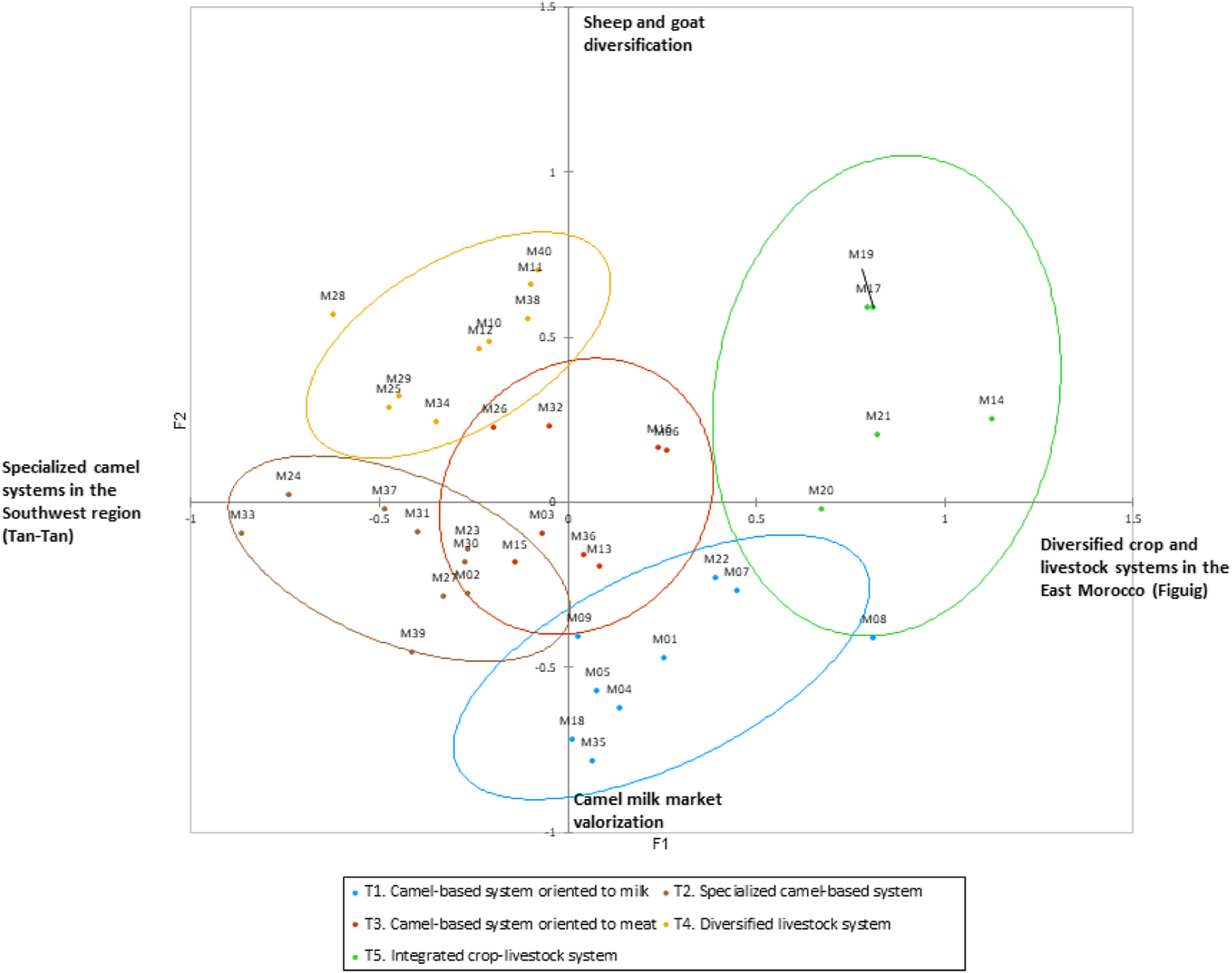
Projection of the 5 clusters on the first factorial plan (F1*F2).
TABLE 3
| Classes | Type 1 | Type 2 | Type 3 | Type 4 | Type 5 | Av. Sample |
|---|---|---|---|---|---|---|
| Small milk-oriented camel farm system | Large specialized camel system | Small meat-oriented camel farm system | Large mixed livestock system | Mixed crop-livestock system | ||
| Region | Zagora | Tan-Tan/Guelmin | Zagora > Figuig > Assa-Zag | Tan-Tan, Zagora | Figuig, Errachidia | All |
| Av. age | 63 | 45 | 54 | 55 | 55 | 54 |
| School level of the family head | Analphabeth | Secondary | Analphabeth Coranic school |
Coranic school | Analphabeth | |
| Off-farm activity | Trader/retired | Trader | No/retired | No/other | Representative | |
| Producers who got camel in inheritance (%) | 33% | 22% | 50% | 56% | 40% | 40% |
| Producers with camels in no-ownerships (%) | 22% | 67% | 38% | 44% | 20% | 40% |
| Producers with lands in ownerships (%) | 33% | 33% | 75% | 33% | 20% | 40% |
| Palm trees (av.nos. Trees) | 111 | 56 | 46 | 33 | 32 | 58 |
| Producers who cultivate barler (nos.) | 1.1 | 0.0 | 0.0 | 2.2 | 2.1 | 1.0 |
| Sheep (av. heads) | 8 | 0 | 16 | 177 | 41 | 50 |
| Goat (av. heads) | 35 | 19 | 106 | 142 | 61 | 73 |
| Producers who have cattle | 0 | 0 | 0 | 2 | 0 | 0 |
| Camels (av. heads) | 20 | 89 | 29 | 86 | 49 | 56 |
| Racing camels (av. heads) | 0 | 6 | 0 | 2 | 0 | 2 |
| Shepherd on camel | 22% | 78% | 88% | 100% | 100% | 75% |
| Grazing land distance in good climatic year (km) | 166 | 153 | 87 | 191 | 6 | 134 |
| Grazing land distance in bad climatic year (km) | 95 | 204 | 392 | 169 | 253 | 216 |
| Producers who practice camel fattening | 2 | 0 | 2 | 2 | 2 | 8 |
| Producers who sell camel milk | 44% | 44% | 13% | 11% | 0% | 25% |
Descriptive characteristics of the family farm activities (sample: 40 camel breeders, 2019).
The types (T2) and (T4) are representing the specialized livestock systems of the arid desert lands in the south west and east of Morocco that are distinguished from the mixed crop-livestock systems (T5) that are context-specific to the oasis areas in the east and north east of Morroco. The types (T2) and (T4) haveon average between 85 and 90 camels, with a maximum of 150 animals, mainly managed in pasturelands. The radius of mobility varies from 150–200 km to 900–1,200 km according to the climate conditions. The main difference between the two types is the degree of association of sheep and goats in the herd. The type (T2) is specialized in camel raising with a camel trade activity. Moreover, some of them practiced training and concurring for camel races organized during the festivals in the region. Besides, the type (T4) is essentially oriented to traditional camel raising with sheep and goats (more than 300 sheep and goats in the flock), mainly oriented to live animal commercialization. We can see that the type (T2) includes the youngest herders in the sample with an average age of 45 years old, compared to 54 years old in the total sample.
On the opposite, the type (T5) is a diversified system with camel (50 heads), sheep and goats (around 100 heads), palm or olive trees, and annual crops. They also cultivated alfalfa under the palms to feed the animals. This system is mainly represented in the oasis of the Figuig and Arachidia regions in the east and southeast of Morocco.
In between, we can identify two types (T1) and (T3) with a small camel herd of around 20–30 heads. The main difference between these two groups is the diversification or not toward milk valorization. Notably, the type (T1) has started the milk valorization with a small she-camel herd conducted indoor. Table 3 gives a rapid description of the five types.
These five types are not representative of each administrative zone, but they give an overview of the main camel-based systems that are representative of the dry and desert areas of Morocco.
Profile of the contribution of camel activity to the domestic economy
Camel products for domestic use
Overall 70% of camel meat and 32% of camel milk are transformed for home consumption. The most frequent milk products are butter, fermented milk (leben), cheese, and buttermilk, with no dominant product. If the leben is directly obtained from the milk fermentation, the buttermilk is fermented milk, traditionally obtained from fresh or fermented cream and after making the butter by churning. The main cheese product, called Klila, is a fresh or hard cheese obtained after a process of fermentation, heating, and exposure to the sun for dehydration. For meat and despite the presence of a freezer in the majority of the houses, the preservation of meat and hump in the form of gueddid (salted and dried meat) or Tichtar (directly sun-dried for two or 4 days), Khlea (mixture of dried meat confit in fat) and Oudeg (local naming for cooked and stored bump) still persists. These processes allow stocking the meat at least for 1 year and more. Beyond the food use of camel products, the families use also the skins and wool for traditional medicine or the tent, and also the urine, mainly for healthcare. Figure 4 represents the different use of camel products at home.
FIGURE 4
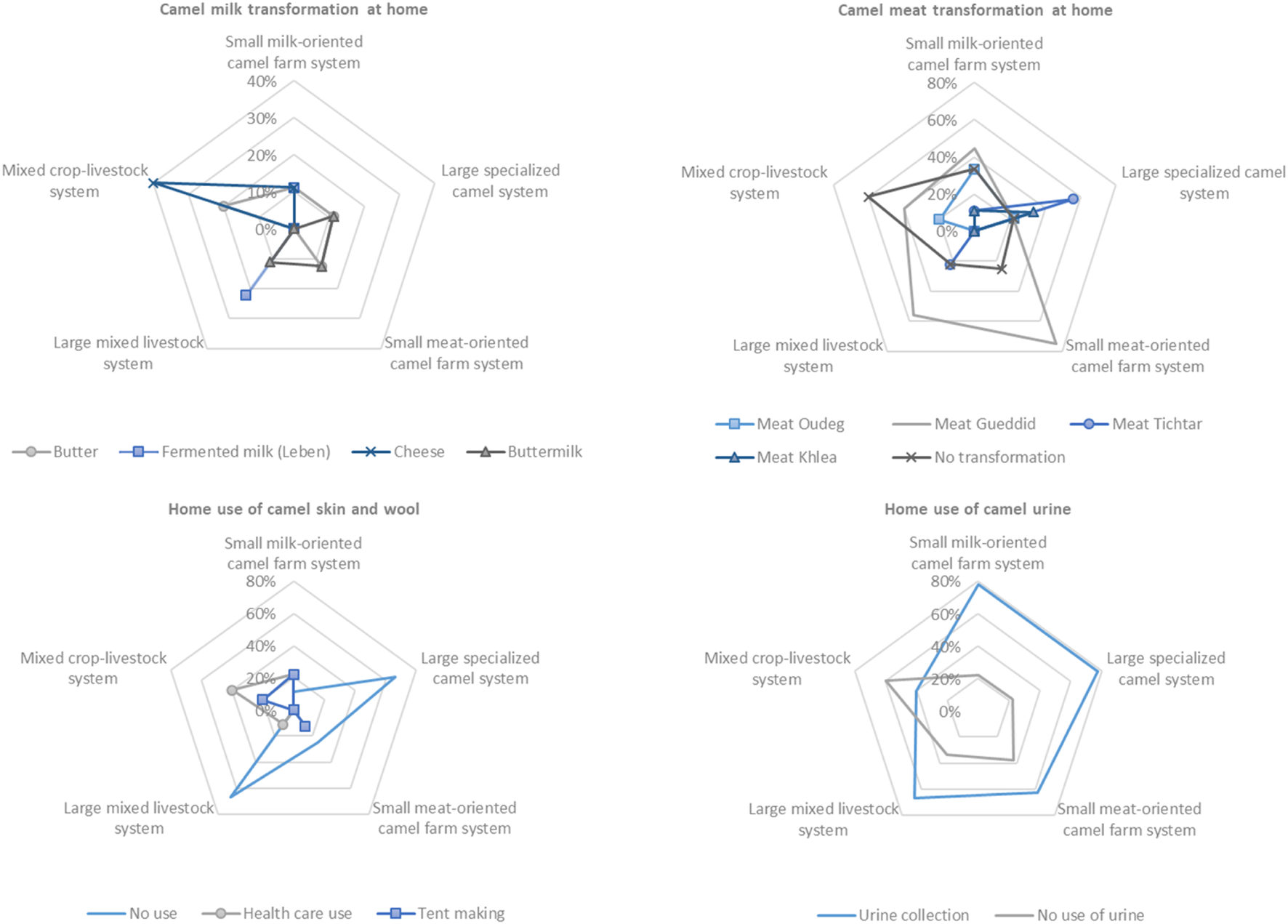
Multi-use of camel products for domestic purposes according to camel-based farming systems.
The most diversified use of camel products concerns the mixed crop-livestock systems. 60% of households in this group (T5) transform camel milk into butter and cheese and the same percentage is used to produce Guedid and Ouedeg meat preparation. In the small milk-oriented system, 10% valorize milk with butter, Leben, and cheese. For the large specialized livestock systems, the main milk product was butter for T2 and fermented milk (leben) for T4. This difference is mainly due to the dominant regional traditions of the two types, southwest Morocco for T2 and east and south east for T4. For meat home use, the main meat preparation is the gueddid, mainly for T3 and T4 oriented to the live animal market, and tichtar for the specialized camel system (T2). Ouedeg preparation is the most popular in the diversified crop-livestock system (T5) and the small camel milk-oriented system (T1) with in-door camel management. Regarding the use of skin and wool, contrasted profiles according to camel management are observed, with an increasing valorization of these products in the fixed camel system in the oasis and, to a lesser extent, for the in-door management system of the small camel milk-oriented system and this mainly for traditional medicine.
Finally, from 40% to 80% of households collect urine mainly used in traditional medicine for the family.
Camel products for income generation
Beyond the multi-use of camel products at home, the camel activity constitutes generally an important source of income represented in Figure 5. Regarding milk valorization, the main destination is the milk home consumption (representing on average 80%–100% of the use of the collected milk) and, secondly, the milk donation concerning around 58% of the sample with an important difference between the type T1 of the youngest camel herders oriented to milk valorization and the other types. Two systems T1 and T2 sell milk, mainly through direct sales to consumers. And few herders use market chains, mainly represented by the presence of middlemen or retailers. For meat, the majority of the valorization is the live animal sale passing through specialized traders. However, around 30% of the live animal sales of the large camel herders (i.e. T2 and T4) are direct sales to consumers (some large camel herders are also traders). The sales to butchers concern from 10% to 20% of total sales and are mainly practiced by small meat-oriented camel systems in the South East part of Morocco. Camel used for tourism or festivals are mainly developed by the youngest herders in the type T1.
FIGURE 5
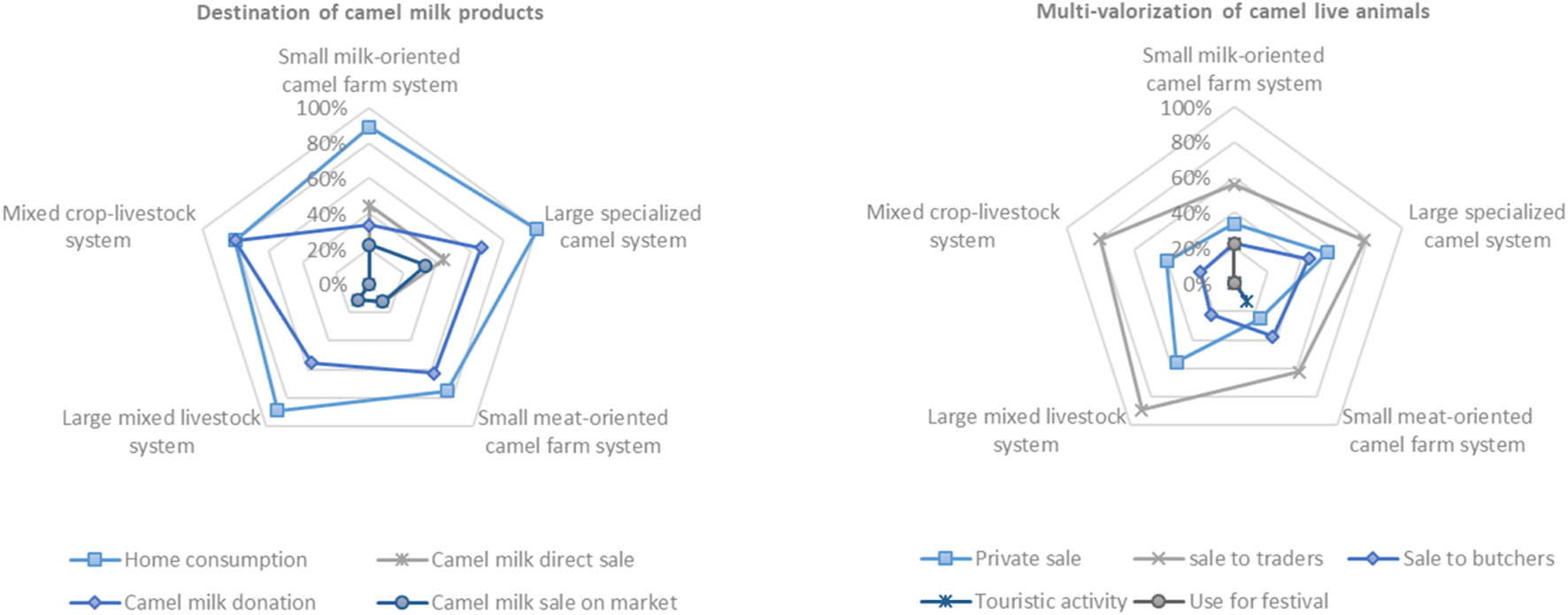
Diversification of outlets for camel products.
Camel as a reserve of capital
If the camel activity constitutes an important source of monetary income and, consequently, cash entry for around 90% of the family heads in the sample, camel herding also remains a source of live capital with two main goals: (1) constituting a family net safety for around 40%, and (2) constituting a cash reserve for farm or non-farm investment for almost 10% (Figure 6). The priority given to family net safety is predominantly mentioned by the mixed crop-livestock systems in the oasis and the small milk-oriented systems, although the priority given to capital for investment only concerns the small meat-oriented camel systems (T3) and the large specialized camel systems (T4). The systems oriented to camel products valorization through milk marketing (T1) or multi-species animal system (T4) invest mainly in camels as reproductive stock for renewing the herd. These two types invest, respectively, in milk-performant animals or good conformation for live animal sale. The behavior of animals interven mainly in the types T2 and T3 that conduct their herd on pastureland.
FIGURE 6
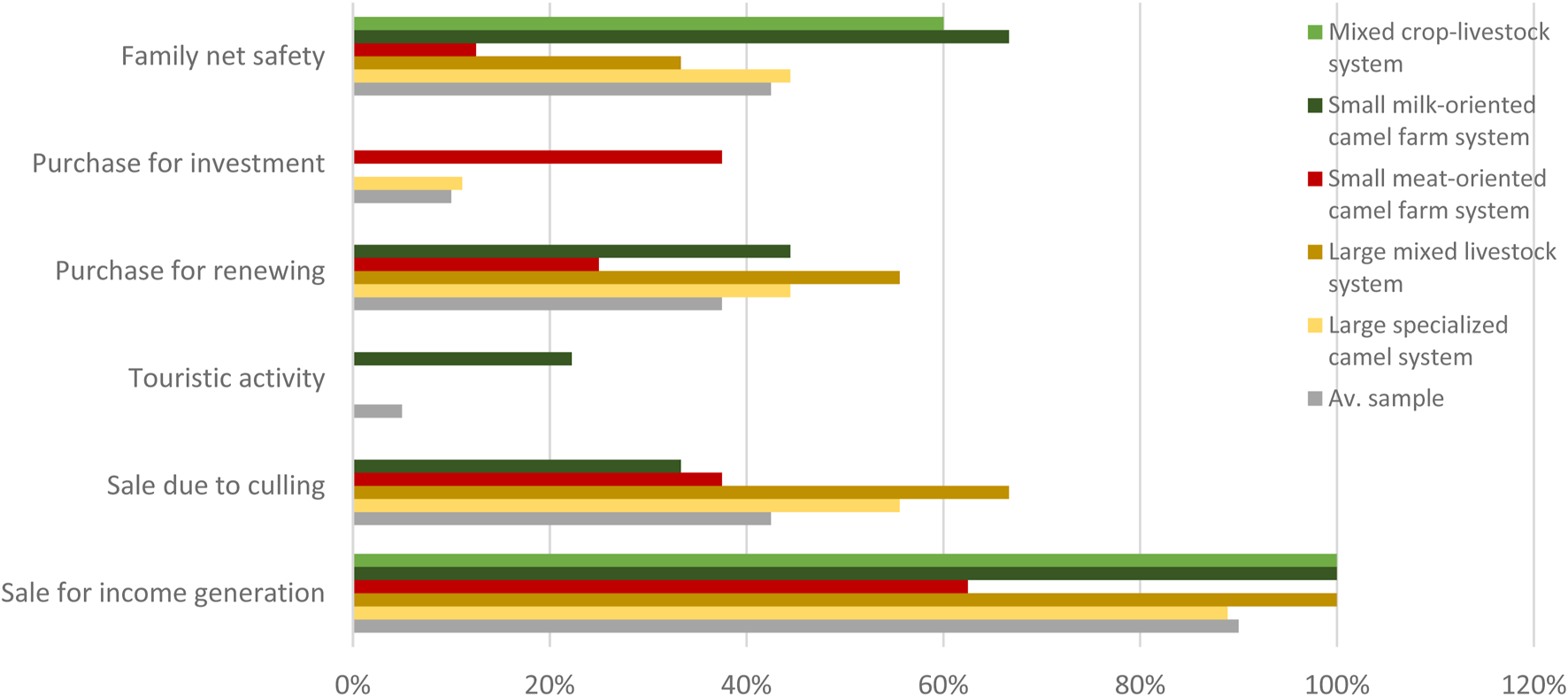
Reasons of sale or purchase of camel animals (in % for each type).
Cash income contribution of camel activity and its perception
By estimating the net income generated by the camel activity at the family farm level based on the products and costs declared by camel herders, the contribution of the camel herd to the household livelihood in these dry and desert zones was assessed (Table 4). The products value was calculated from the all camel products valorized at the selling price. The camel activity provids an average income of 120,000 Moroccan Dirham (MAD) by household (equivalent to 12,460 USD) in 2019. This income is four times the minimum wage fixed at around 3100 USD$ per year in 2019 in Morocco. The mixed crop-livestock system is close to this poverty threshold with an average annual net income of around 37,000 MAD from the camel activity, followed by the small meat-oriented camel system with 60,000 MAD. Not surprisingly, the highest camel net incomes are recorded for the large camel system (T2 and T4). However, we can notice that the type (T1) achieves good results linked to the multi-use and multi-valorization of the camel herd through milk, meat, and also some touristic activities and participation in festival events. So these results reveal the difference in income generation according to the function of the camel herd management. The net income per animal varied from 600 MAD to 8100 MAD (or 62 to 877 USD per camel head).
TABLE 4
| Items of products and charges | Small milk-oriented camel farm system | Large specialized camel system | Small meat-oriented camel farm system | Large mixed livestock system | Mixed crop-livestock system | Av. Sample |
|---|---|---|---|---|---|---|
| Products | ||||||
| Milk | 83,076 | 75,538 | 0 | 28,389 | 0 | 43,446 |
| Live animals | 77,711 | 187,375 | 104,117 | 165,056 | 82,000 | 127,530 |
| Racing | 0 | 95,833 | 0 | 22,222 | 0 | 26,126 |
| Skin and wool | 0 | 0 | 0 | 0 | 800 | 108 |
| Animal purchase | 17,500 | 120,500 | 31,500 | 35,400 | 51,469 | |
| Production cost | ||||||
| Feed | 30,359 | 62,895 | 13,647 | 33,371 | 8,800 | 32,503 |
| Healthcare | 411 | 625 | 83 | 444 | 1780 | 597 |
| Material | 1842 | 30,716 | 1925 | 892 | 14,468 | 9,573 |
| Fuel | 5,166 | 6,634 | 6,067 | 4,278 | 1,350 | 4,898 |
| keeper | 1,289 | 938 | 750 | 1,522 | 0 | 1,008 |
| Fixed costs | ||||||
| Equipement (water pump, citern, tent.) | 1,641 | 3,525 | 2,559 | 3,091 | 1,198 | 2,490 |
| Permanent worker | 2,576 | 46,200 | 19,000 | 38,267 | 16,240 | 25,199 |
| Income generation | ||||||
| Gross margin per camel system | 119,560 | 207,213 | 61,369 | 135,858 | 37,372 | 121,933 |
| Net income per household | 117,882 | 203,263 | 59,832 | 133,352 | 37,372 | 119,812 |
| Net income per animal | 8,169 | 2014 | 1,457 | 1,685 | 602 | 3,150 |
Gross margin and net income of the camel activity by household farm systems.
Camel contribution at the local and regional level
The contribution of camel farming to the market economy
As revealed in the previous section, camel breeding provides food products (meat and milk), which are marketed through value chains. The meat sector is the most developed and it mobilizes an important number of actors: breeders, retailers, butchers, feed suppliers, veterinarians, transporters, cutthroats, and consumers (Alary et al., 2021). Figure 7 gives a simplistic description of the camel meat value chain. The downstream link of the sector brings together breeders, who marketed their animals, and the retailers (« berghaza ») who bought camel to breeders to fatten them and sell them. In this chain, the animals are sold on the rangelands or at the markets (« souk »), in particular the market of Amhirich, in Guelmim which is considered one of the biggest camel markets at the national scale (Figure 8).
FIGURE 7
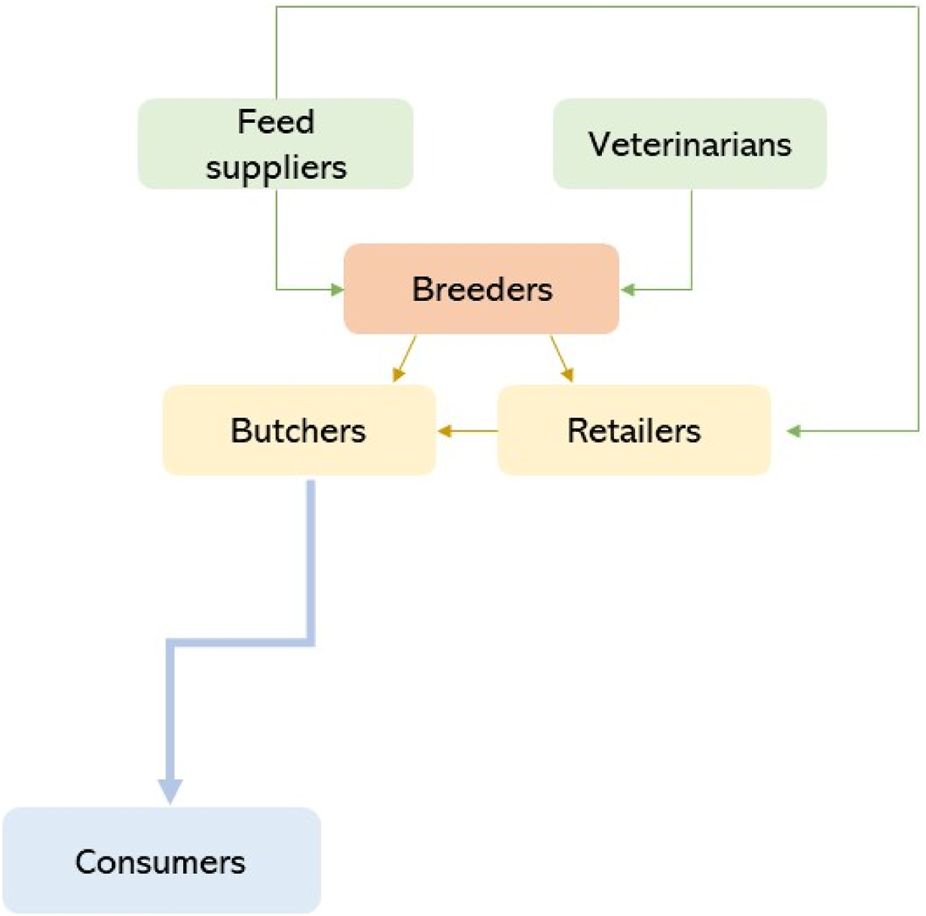
Mapping of the camel meat sector. Source: extracted and adapted from Mnaouer, 2019.
FIGURE 8
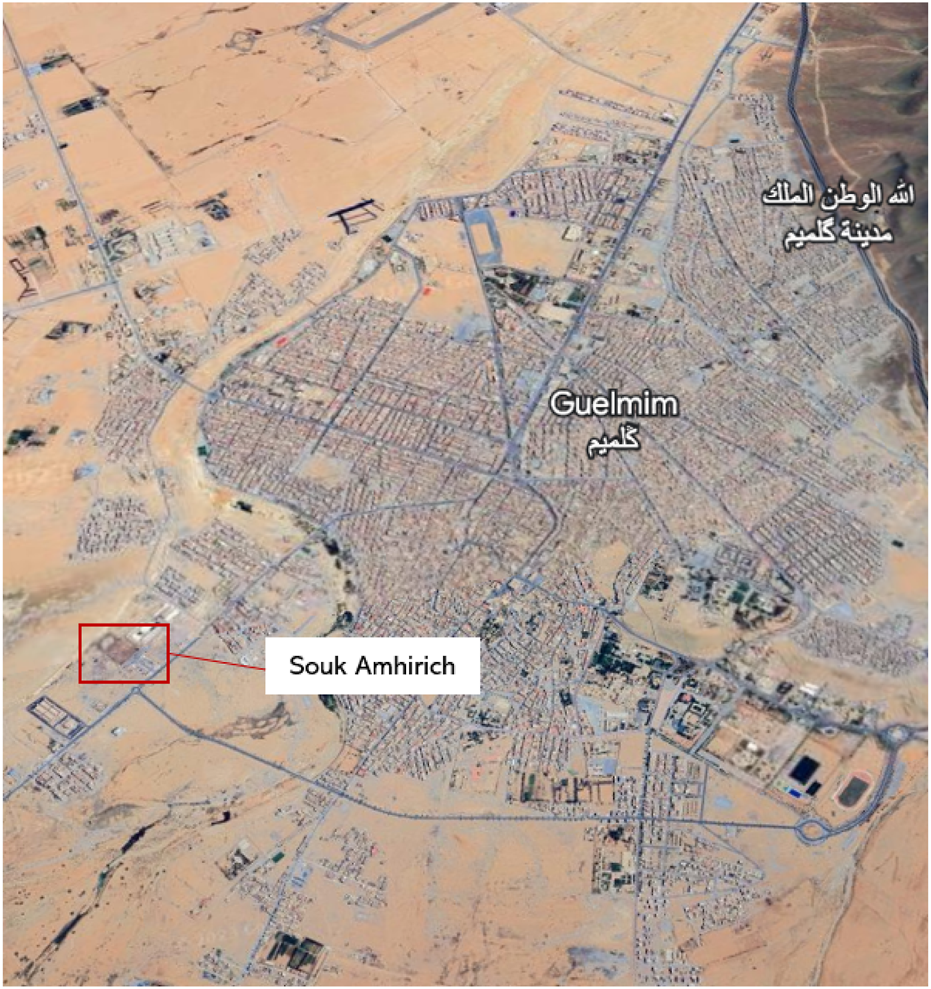
The market of Amhirich in Guelmim, one of the biggest camel markets at the national scale. Its position near the National 1 enables it to be linked from the north to the south of the country. Source: Google Maps.
The majority of camels marketed for meat are under 24 months old but some are also older reformed camels, specifically those slaughtered for ceremonies. Butchers are then the central link in the value chain. They operate in small shops in urban centers and they carry out the majority of activities, from collecting the animals from breeders or traders to retailing the meat. This includes slaughter, skinning, transport, and storage of carcasses as well as cutting and trimming of the meat (e.g. into minced meat). Camel meat is sold between 70 and 75 MAD/kg (or 6.92 to 7.42 USD/kg) and is less expensive than sheep meat (around 80 MAD/kg, or 7.91 USD/kg). Finally, the downstream link in the chain is made up of consumers, with a majority originating from the Saharan zones for whom camel meat is part of their food habits and preferences. They cook it very simply in a pot with spices, oil, or vegetables (as it was prepared by nomadic populations) or use in traditional Moroccan dishes such as couscous or tajine. The consumption of camel meat produced in the Saharan provinces is limited to the local population or a few national or international tourists passing through these regions, as it isn’t exported on a national or international scale.
Regarding camel milk, the value chain is currently underdeveloped in the studied areas because for a long time, the idea that “it is shameful to sell camel milk as it is a gift from God” (citation from a breeder from the Guelmim region interviewed during the survey in 2019) was widespread. For the moment, the embryon of the value chain (Figure 9) consists of three main actors: producers (breeders or cooperatives), retail sellers, and consumers. As the milk is marketed in its raw or scalded state (« Frik », « Ftir » or « Lben »), it is sold through short marketing channels: either the producer sells directly milk to the consumer, or he sells it to grocery shops or dairies (« Mahlaba ») who then market it to consumers (Photo 1). For now, there is no milk collection and storage system: the producer himself makes deliveries to consumers’ homes or grocery shops and dairies. In 2019, there is only one milk pasteurization factory located in the southern zone, in Guelmim, built as part of a project under Pillar II of the Green Morocco Plan, but it isn’t operational yet.
FIGURE 9
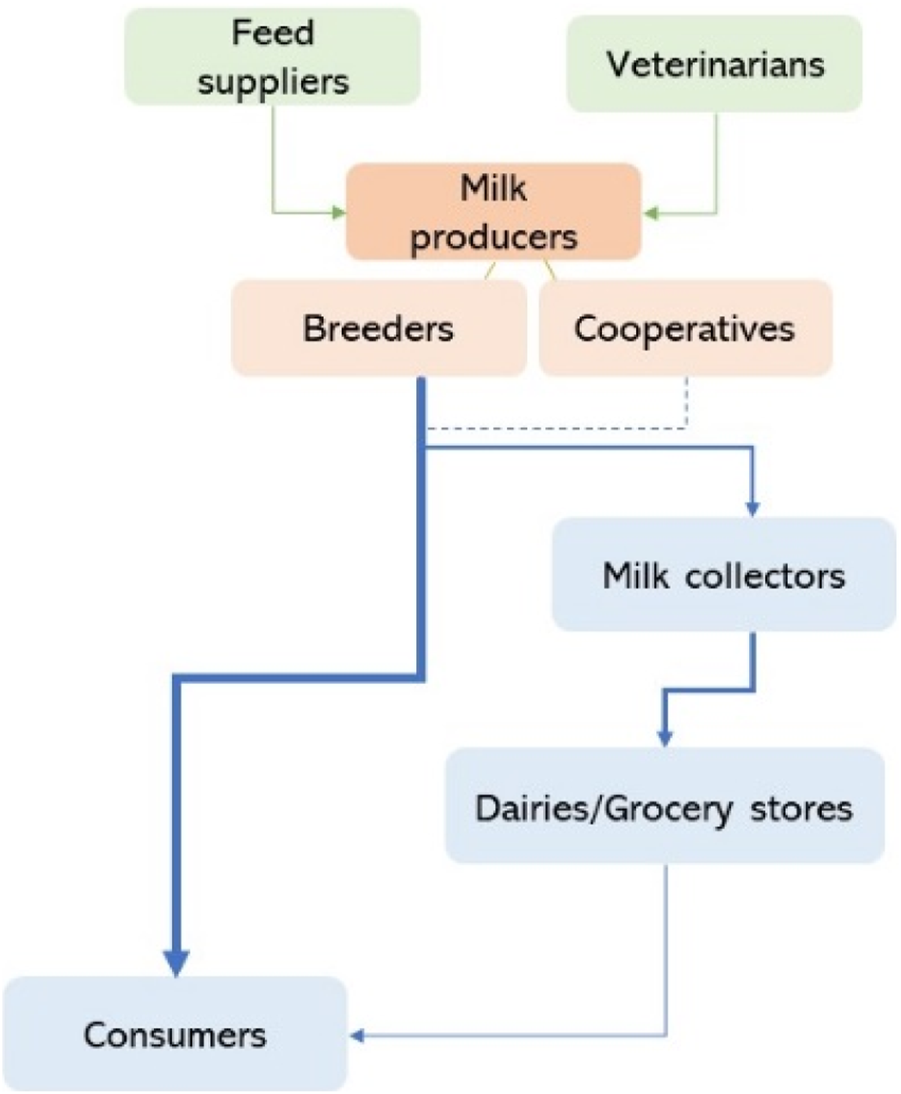
Mapping of the camel milk sector (Mnaouer,2019). Source: extracted and adapted from Mnaouer, 2019.
PHOTO 1
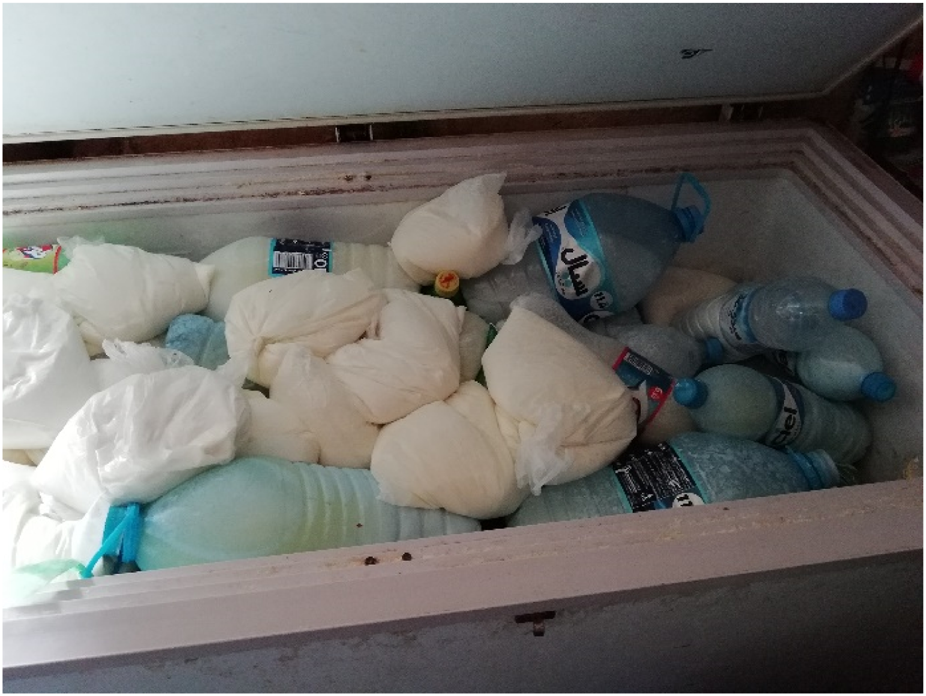
A store selling cow milk and camel milk in Tan-Tan (authors, 2019).
Milk processing for marketing was very rare. Only one producer-seller was encountered in the province of Errachidia. He sells the milk after processing it in a salesroom built on the side of a national road. The processing of milk into butter (« Dhen »), buttermilk (« Lben ») and dehydrated cheese (« Klila ») is traditionally done by his wife (Mnaouer, 2019). Camel milk is sold at about 10 MAD/L (or 0.98 USD per liter) and can go up to 30 MAD/L (or 2.96 USD per liter), which is relatively a high price compared to goat’s or cow’s milk (around 4-5 MAD per liter in 2019, 0.44 USD per liter). It can be explained by transport costs since camels are on pastoral rangelands far from urban centers and also by the therapeutic virtues attributed to this milk, which makes it much more than a simple food product on the market.
The contribution of camel breeding to the service economy
By its physical and physiological capacities, the camel contributes to the regulation of rangelands. Its feeding behavior is based on ambulatory grazing during which it feeds over long distances on the meagre pastoral resources it needs, its renal and intestinal systems allowing it to assimilate most of the nutrients. The particular anatomy of its feet allowed it to follow all the irregularities of the ground and thus have no aggressive effects on the soil. Finally, its excrements, in which the seeds begin their germination, help the dispersion of plant resources in the desert (Faye, 2013; Trabelsi, 2023). The dromedary thus makes it possible to fight against the desertification of arid zones: “It is […] the one by whom the sand does not return to its eternal sterility. It is the one by which the desert remains habitable now of heroic bushes that adapt to the omnipresence of sand.” [2013, 67 (free translation)].
In addition to these environmental services, camel husbandry provides cultural services, defined as « intangible benefits derived from ecosystems » (ASSESSMENT, Millennium Ecosystem, 2005). As a symbol of Saharan identity and nomadic lifestyle, the camel have a strong cultural and social value, as evidenced by its central role in customary rites and ceremonies. During tribal festivals (“zaouia”), for example, all the members of the tribes contribute to buying the dromedary that will be slaughtered on the tomb of the tribes’ saints. Similarly, during weddings, the families of the bride and groom have to slaughtered one or more dromedaries to offer to the guests for the meal. As a woman in the province of Tan Tan explained: “Buying a dromedary and having it slaughtered is obligatory during Sahrawi gatherings. If you make something else to eat, it’s as if you haven’t done anything because they won’t eat it” (interview conducted in Decembre 2019).
Because of the cultural importance of camel breeding, the image of the dromedary is an omnipresent marker of studied Saharan and pre-Saharan territories, as evidenced by the presence of statues in urban centers with its effigy (Photo 2), and is mobilized for commercial purposes.
PHOTO 2
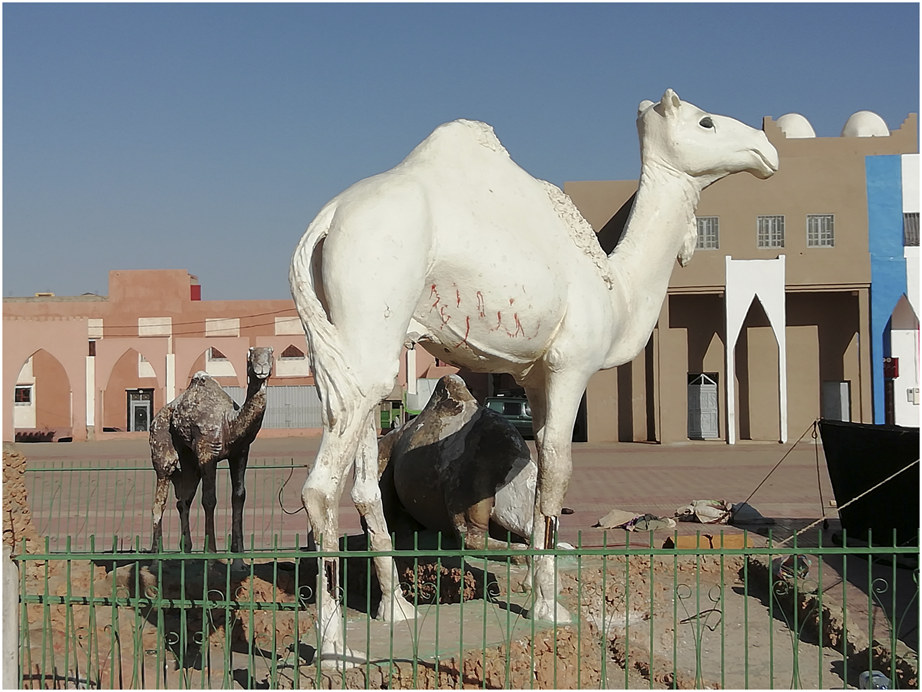
Camel statues in urban centres of Assa and Guelmim (authors, 2019).
The camel is thus at the centre of the touristic and leisure economy that have known a certain development in the studied regions since the late 1980s. To meet the expectations of national and international tourists, some territories have been built entirely on the mythical image of the desert through a staging of the nomadic heritage, of which the camel is an integral part. Events aimed at promoting Sahrawi culture with camel as the emblematic animal in the communication strategy and/or their programming are also increasingly numerous and attract local, national, and foreign populations, such as the Taragalt festival in M’hamid or the Moussem of Tan Tan, listed as a UNESCO World Heritage Site since 2008 (Photo 3).
PHOTO 3

The image of the camel as a communication tool to promote the Saharan culture. Sources: extracted from internet websites of the Taragalt festival and the Moussem of Tan Tan.
Discussion
The main results of the socioeconomic contributions of camel activities in the arid and desert zones of Morocco reveal the complexity in understanding the viability of this activity only focusing on one scale or one product. Camel activity is emblematic of a multifunctional system in which all the biological, social and economic dimensions are interlinked at the family, local and regional level. Even if some camel farm systems are traditionally specialized on one activity (like meat for large camel herd) or others start a specialization towards milk and racing (e.g., small camel herd), the Saharan society continues to exploit a multiple of co-products for home purposes at the household level or social events at local or regional level. Only the consideration of all this multitude of monetary and non-monetary goods and services can allow understanding the real contribution of this activity in the overall viability of these societies in the arid or desert context characterized by recurrent droughts as observed during the recent years.
However, if the goods and services provided by camel breeding are factors of territorial development in the Saharan and pre-Saharan regions of Morocco, these arid and desertic regions continue to experience a significant emigration toward large Moroccan cities or abroad as well as a high unemployment rate, especially among young people. The latter, especially the educated young generation who are accustomed to the urban lifestyle during their study, are increasingly disinterested in camel farming as practiced by their parents. The recent development of the meat and milk sectors or the touristic activity constitutes for them new employment opportunities and the possibility to apply new practices more adapted to their way of life. For example, during the survey, we met the son of a camel trader who, after graduating from the University of Marrakech, came back to Tan Tan to work with his father, with whom he has an enclosure in town where they sell camels. He pushed his father to use WhatsApp to facilitate their activity: the breeders sent pictures of the camels and this allowed them to make the first negotiations without having to move. In the same line, development of the milk sector is a response to the new consumption practices that are emerging as a result of the sedentarization of nomadic populations in urban centers, which is accompanied by the abandonment of camel farming by several families. However, camel milk and also meat, which the populations used to produce directly on the family farm or to receive from the family or friend network, remain at the center of consumption habits more than a modern value chain as observed for other ruminant species. However, the growing development of demand of camel products from the Moroccan urban middle class offers recent economic alternatives in what we can call “niche market.” For example, camel milk is the subject of a protected geographical indication “Camel milk of the Sahara” since 2016 which includes the municipalities of the three regions of the Moroccan Sahara namely: Guelmim - Oued Noun, Laâyoune - Sakia L’Hamra, and Dakhla - Oued Eddahab, as well as the municipalities of the province of Tata under the region of Souss Massa.
Nevertheless, the camel sector needs to find a new organization modelin order to integrate its multifunctional values. In the framework of the Green Morocco Plan (2008–2020), the development of the sectors was based on policies that encouraged actors to form cooperatives or associations. These forms of collective organization have had difficulty developing in the studied areas where traditional organization around tribes is structuring and, consequently, they have not managed to unite all the actors around common objectives. Many cooperatives are thus not operational and remained financially dependent on public aid. This creates a blockage situation insofar as the public authorities expect the actors to organize themselves once the public aid has been granted.
Moreover, camel farming is still mostly mobile, which allows herders to adapt to the variability of hydro-pastoral resources, which characterizes arid and semi-arid areas. The mobility is always considered as an obstacle to the development of the regional economy by formal institutions. Within the 20th century, mobility has often been considered a brake to modernization and development, and also responsible of insecurity in the remote areas (Turner and Schlecht, 2019). If today mobility starts to be recognized as a adaptive mechanism to global changes, it is still considered by many administrations and public authorities as an issue and challenge to the questions of regulation, control and organization of the value chains and regional development: “mobility prevents the development of the camel milk sector. This poses a problem. Mobility hinders the development of the dairy sector.” (interview conducted with an agent of the DRA of Guelmim, April 2019). Mobility continues to question the development of camel breeding, especially based on the models of the other ruminants’ value chains.
More generally, the multiplicity of functions beyond the production and marketing of camel products leads to envision the development of the camel systems from a multifunctionality perspective, considering the multiples goods and services at the household level and highlighting the recent dynamics of valorization of these products including services and jobs at the local and regional scale. Multifonctionality approach allowed to consider this activity as a social phenomenon at different scales as suggested Jollivet (2004). As shown in the results, camel products are the core of all traditional and social events, including the exchanges and donations that structure the social organizations but also the social regulations on resource access (Amsidder, 2022).
The recent increasing concern of agroecological pathways to ensure social and environmental sustainability in the context of climate change, especially with the intensification of drought events, leads to a renewed interest on camel herding systems. The camel market and non-market goods and services can play a crucial role in terms of territorial development: generate jobs in regions marked by significant emigration, especially among the youngest, development of the meat and milk sectors makes possible to respond to consumption changes following the sedentarization of nomadic populations in urban centres but also to meet the growing demand of the middle-class Moroccan for local products. Finally, these results highlighted the need to search for sustainable development of the camel economy at the interweaving of the multiple goods and services that can be affected differently according to the shocks.
Conclusion
This research study on the economic and noneconomic contributions of camel products (outcomes) in the camel-based society’s wellbeing in North African drylands reveals the multiple contributions of camel activity (at the household and territorial level …). Firstly the results at the household level reveal the multi-use of camel products in the local food system and traditional medicine practices even if the camel income generation comes mainly from the sale of live animals. Approaching this multi-purpose use of camel products allowed us to relativize the general view of this activity as a not economically profitable activity or an economy of ‘annuitant’ due to the perception of a quiet life in the desert. In most of the camel-based systems in Morocco, camel activity is first a source of income and secondly, a net safety that can be converted into investment.
Secondly, this multi-purpose use of camel products at the household level directly questions sectorial policies oriented to milk or meat. The results showed clearly that the highest profitability is recorded in the most diversified camel systems in the studied zone. Consequently, the favouring of camel development in the dry and desert environment needs to conceive multi-sectorial policies that valorize the local food and healthcare system.
Statements
Data availability statement
The raw data supporting the conclusions of this article will be made available by the authors, without undue reservation.
Ethics statement
All interviewed actors gave their oral consent to be interviewed.
Author contributions
LA led the redaction of the paper and contributed to data analysis at territorial level; VA contributed to data processing and analysis at the farm household level; GD contributed to the conceptual frame of the studies and the paper; IM contributed to data collection and data analysis of value chains. All authors contributed to the article and approved the submitted version.
Funding
The author(s) declare that financial support was received for the research, authorship, and/or publication of this article. Funding agency: French National Research Agency (ANR) and CRP Livestock. This research study has been conducted within the CARAVAN project on “Toward a CAmel tRAnsnational VAlue chain” funded by ANR (French National Agency of Research), the Ministry of Higher Education (Morocco) and with the contribution of the CGIAR System and then supported by the project CamelShield on “Les systèmes d'élevage camelins: acteurs du développement économique durable des territoires nord sahariens par des stratégies innovantes de gestion des ressources naturelles et de commercialisation” within the PRIMA call.
Acknowledgments
We particularly thank the Regional Office of Agricultural Development (ORMVAO) in Ouarzazate, the Agricultural Regional Direction (DRA) at Guelmim Oued Noun, and all the technical staff and breeders who collaborated during the fieldwork.
Conflict of interest
The authors declare that the research was conducted in the absence of any commercial or financial relationships that could be construed as a potential conflict of interest.
References
1
Alary V. Amsidder L. Araba A. Capote C. B. Bedhiaf-Romdhani S. Bensalem W. et al (2021). Social network analysis of the stakeholders involved in the dromedary sector in the mediterranean region. Sustainability13, 12127. 10.3390/su132112127
2
Alary V. Lasseur J. Frija A. Gautier D. (2022). Assessing the sustainability of livestock socio-ecosystems in the drylands through a set of indicators. Agric. Syst.198, 103389. 10.1016/j.agsy.2022.103389
3
Amsidder L. (2022). Accéder aux ressources en milieu aride, une affaire de réseaux ? Les stratégies d’investissement social des éleveurs camelins du sud-ouest marocain comme facteur d’adaptation aux changements socio-politiques et climatiques des espaces pastoraux. Montpellier: AgroParisTech.
4
Amsidder L. Alary V. Sraïri T. M. (2021). An empirical approach of past and present mobility management in the desert societies of camel breeders in South Eastern Morocco. J. Arid Environ.189, 104501. Maroc. 10.1016/j.jaridenv.2021.104501
5
ASSESSMENT, Millennium Ecosystem (2005). Synthesis report, 748. Washington, DC: Island.
6
Davis D. K. (2005). Indigenous knowledge and the desertification debate: Problematising expert knowledge in North Africa. Geoforum36, 509–524. 10.1016/j.geoforum.2004.08.003
7
FAO (2020). Données sur les cultures et produits animaux. https://www.fao.org/faostat/fr/#data/QCL.
8
FAO (2023). Data on agriculture and livestock production. Rome, Italy: Faostat. Available at: http://faostat.fao.org.
9
Farah Z. (1993). Composition and characteristics of camel milk. J. Dairy Res.60, 603–626. 10.1017/S0022029900027953
10
Faye B. (2013). La dune et la bosse. Tech. & Cult., 60–75. Revue semestrielle d’anthropologie des techniques. Les Éditions de l’EHESS. 10.4000/tc.7222
11
Faye B. (2018). The improvement of camel reproduction performances: Just a technical question?Revue Marocaine des Sci. Agronomiques Vétérinaires, 6 (2), 265–269.
12
Faye B. (2019). L’économie cameline au XXIe siècle: situations et perspectives. Actes de la journée d’étude de la Société d’Ethnozootechnie. Paris (France)2019-06-06.
13
Faye B. Grech S. Korchani T. (2004). Le dromadaire, entre féralisation et intensification. Anthropozoologica.
14
Goodman L. A. (1961). “Snowball sampling,” Ann. Math. statistics, 148-170. 10.1214/aoms/1177705148
15
HCP (2019). Monographie de la région de Guelmim Oued Noun. Haut Commis. Plan, Dir. régionale Guelmim.
16
HCP (2021). Monographie régionale du Drâa Tafilalet. Haut Commissariat au Plan. Dir. régionale Drâa Tafilalet.
17
Hesse C. Macgregor J. (2009). Arid waste? Reassessing the value of dryland pastoralism. Available at: https://www.iied.org/17065iied.
18
Jollivet M. (2004). La multifonctionnalité de l’activité agricole, nouvel avatar du fait social total?In Multifonctionnalité des activités, pluralité des identités. Editors LaurentC.RémyJ. D. (Les Cahiers de la Multifonctionnalité).
19
Julien L. Moutik F. E. Haloui C. Huguenin J. Sraïri M. T. (2021). Paramètres démographiques et économie de l’élevage camelin: une étude au Maroc. Cah. Agric.30, 1. EDP Sciences. 10.1051/cagri/2020039
20
Kaufmann B. A. (2005). Reproductive performance of camels (Camelus dromedarius) under pastoral management and its influence on herd development. Livest. Prod. Sci.92, 17–29. 10.1016/j.livprodsci.2004.06.016
21
Konuspayeva G. Faye B. Loiseau G. (2009). The composition of camel milk: a meta-analysis of the literature data. J. Food Compos. Analysis22, 95–101. 10.1016/j.jfca.2008.09.008
22
Lazarev G. (2015). Les mouvances de population dans les provinces sahariennes. De l’histoire à aujourd’hui. Crit. économique. 10.48409/IMIST.PRSM/ce-n33.10277
23
Mnaouer I. (2019). Analyse des chaînes de valeur camelines au Maroc et les multiples fonctions économiques du dromadaire. Mémoire de fin d’études. Institut Agronomique et Vétérinaire Hassan II.
24
Senoussi Dr A. (2011). Le camelin: facteur de la biodiversité et à usages multiples. Actes du Séminaire Int. sur la Biodiversité Faunistique en Zones Arides Semi-arides, 2, 265–273.
25
Trabelsi H. Chehma A. Senoussi A. Faye B. Kherraze M. E. (2023). Camel potentiality in survival and germination of wild pastoral species: the case of Fabaceae in Sahara rangelands of Algeria. J. Arid Environ.216, 105015. 10.1016/j.jaridenv.2023.105015
26
Turner M. D. Schlecht E. (2019). Livestock mobility in sub-Saharan Africa: a critical review. Pastoralism9, 13. 10.1186/s13570-019-0150-z
27
Ward J. H. (1963). Hierarchical grouping to optimize an objective function. J. Am. Stat. Assoc.58, 236–244. Taylor & Francis. 10.1080/01621459.1963.10500845
Summary
Keywords
camel breeding, territorial development, rural economy, pastoralism, arid land
Citation
Amsidder L, Alary V, Duteurtre G and Mnaouer I (2024) The economic contribution of camel-based livestock systems in North-African drylands: the case of East and South Moroccan provinces. Pastor. Res. Policy Pract. 14:13600. doi: 10.3389/past.2024.13600
Received
30 July 2024
Accepted
29 August 2024
Published
12 September 2024
Volume
14 - 2024
Edited by
Carol Kerven, University College London, United Kingdom
Updates
Copyright
© 2024 Amsidder, Alary, Duteurtre and Mnaouer.
This is an open-access article distributed under the terms of the Creative Commons Attribution License (CC BY). The use, distribution or reproduction in other forums is permitted, provided the original author(s) and the copyright owner(s) are credited and that the original publication in this journal is cited, in accordance with accepted academic practice. No use, distribution or reproduction is permitted which does not comply with these terms.
*Correspondence: Lina Amsidder, l.amsidder@iram-fr.org
Disclaimer
All claims expressed in this article are solely those of the authors and do not necessarily represent those of their affiliated organizations, or those of the publisher, the editors and the reviewers. Any product that may be evaluated in this article or claim that may be made by its manufacturer is not guaranteed or endorsed by the publisher.